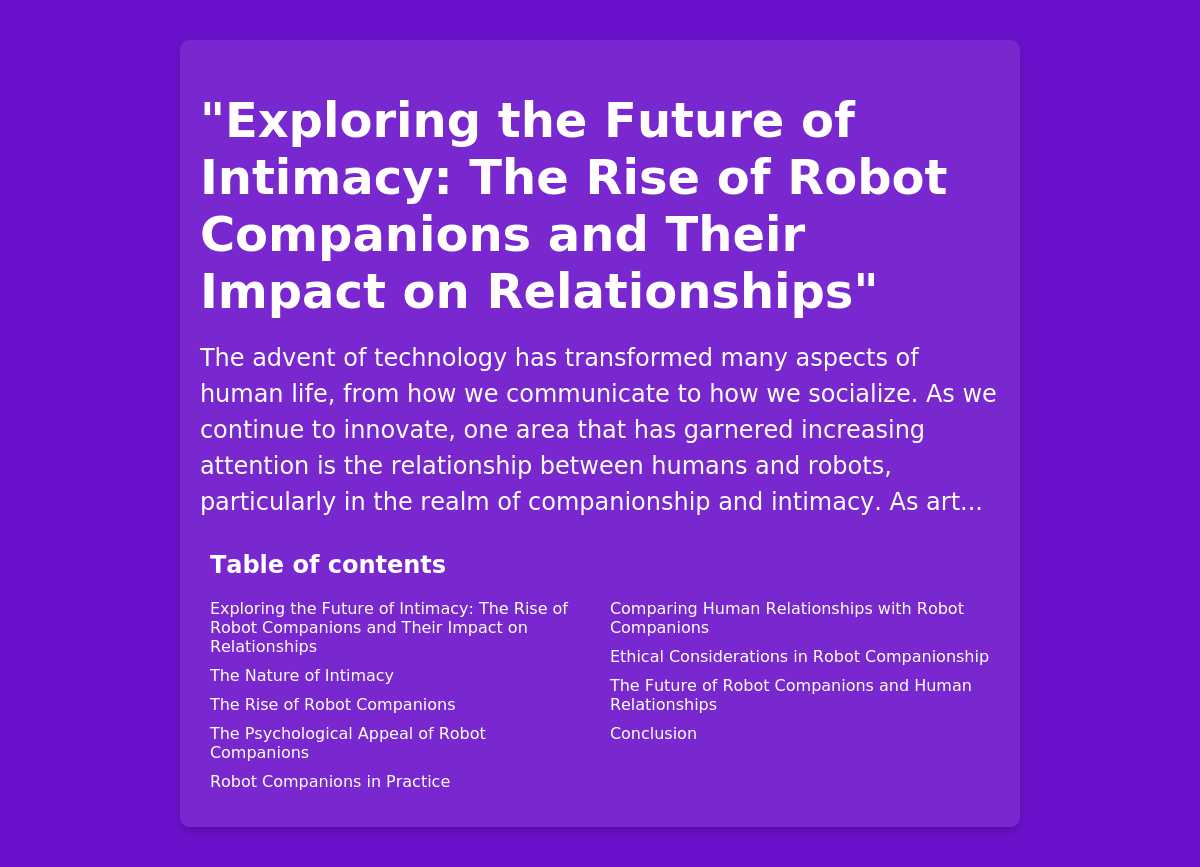Exploring the Future of Intimacy: The Rise of Robot Companions and Their Impact on Relationships
Exploring the Future of Intimacy: The Rise of Robot Companions and Their Impact on Relationships
The advent of technology has transformed many aspects of human life, from how we communicate to how we socialize. As we continue to innovate, one area that has garnered increasing attention is the relationship between humans and robots, particularly in the realm of companionship and intimacy. As artificial intelligence (AI) and robotics evolve, the prospect of robot companions becomes more tangible, ushering in a new era of relationships that challenges our traditional definitions of intimacy.
The Nature of Intimacy
Defining Intimacy
Intimacy is often characterized by a close familiarity and emotional connection between individuals. It encompasses various dimensions, including emotional, physical, and psychological closeness. The modern conception of intimacy involves not only romantic relationships but also deep friendships and familial bonds. Understanding the nature of intimacy is essential as we contemplate how robot companions might influence human connections.
Types of Intimacy in Human Relationships
| Type of Intimacy | Description | Examples |
|---|---|---|
| Emotional Intimacy | Sharing feelings and thoughts to build connections | Confiding in a friend |
| Physical Intimacy | Physical closeness or affection | Hugging, holding hands, or sexual acts |
| Intellectual Intimacy | Sharing ideas and engaging in thoughtful discussions | Debate on philosophical topics |
| Experiential Intimacy | Building connections through shared experiences | Traveling together or undergoing challenges |
| Spiritual Intimacy | Shared beliefs and values that foster a bond | Joint participation in religious practices |
The Rise of Robot Companions
Understanding Robot Companions
Robot companions, or social robots, have been designed to interact with humans in a socially meaningful way. They leverage advancements in AI to understand and respond to human emotions and behaviors. Examples include robotic pets, virtual assistants, and humanoid robots. This section explores the progression of robot companions from rudimentary machines to sophisticated entities capable of forming quasi-relationships.
Historical Context
The development of robot companions can be traced back to early mechanical toys and robots in the 20th century. During the late 20th and early 21st centuries, technological advancements led to the creation of more sophisticated robots equipped with basic AI, enabling them to participate in basic conversations and exhibit lifelike behaviors.
Timeline of Robot Companion Development
| Year | Milestone | Description |
|---|---|---|
| 1966 | ELIZA | One of the first chatbots that could simulate conversation. |
| 1996 | Aibo | Robotic pet developed by Sony that could learn and interact. |
| 2000 | Paro | Therapeutic robot designed to provide comfort to patients. |
| 2016 | Sophia | Robot with advanced AI capable of holding conversations and expressing emotions. |
| 2020 | Virtual Companions | Growth in apps and platforms providing avatar-based companions. |
The Psychological Appeal of Robot Companions
Loneliness and Isolation
In today’s fast-paced world, feelings of loneliness and social isolation are increasingly common. Studies show that many people experience loneliness regardless of their social networks, leading researchers to explore alternative avenues for companionship. Robot companions can fill gaps in human relationships by offering a constant presence, which can be especially beneficial for vulnerable populations such as the elderly or those with mental health challenges.
Emotional Connection with Robots
Human beings have a remarkable capacity to form emotional connections with non-human entities. This phenomenon can be partially attributed to the uncanny valley effect, where humanoid robots that resemble humans elicit emotional responses. These connections may become more complex and realistic as technology advances, allowing individuals to interact with robots that can learn and adapt to their emotional needs.
Factors Influencing Emotional Attachment to Robots
| Factor | Description |
|---|---|
| Anthropomorphism | The tendency to attribute human traits and emotions to robots. |
| Responsiveness | A robot’s ability to respond to human emotions can enhance attachment. |
| Customization | The opportunity to personalize a robot increases the likelihood of forming a bond. |
| Loneliness | The emotional state of the user can influence their attachment to a robot. |
Robot Companions in Practice
Examples of Robot Companions
The integration of robot companions into daily life has seen fascinating developments. From therapeutic robots to personalized AI assistants, various forms have emerged, each designed to cater to specific needs.
Popular Robot Companions
| Robot Name | Description | Area of Application |
|---|---|---|
| Aibo | Robotic pet that learns and interacts emotionally | Companionship |
| Paro | Therapeutic robot designed for comfort and companionship in healthcare settings | Elderly care |
| Kiki | Virtual companion app that provides conversation and companionship | Mental wellness |
| Buddy | Social robot with a range of interactive capabilities including home automation | Family and lifestyle |
| Sophia | Humanoid robot capable of realistic conversation and social engagement | Media and public interaction |
The Role of AI in Enhancing Connectivity
Artificial intelligence plays a critical role in enhancing the emotional connectivity between humans and robots. By analyzing data from interactions, AI algorithms can adapt responses, recognize patterns in behavior, and even understand emotional nuances, creating a more personalized experience.
Comparing Human Relationships with Robot Companions
Similarities and Differences
Understanding how relationships with robot companions compare to traditional human relationships can provide valuable insights into their potential impact on intimacy and socialization.
Comparison of Human and Robot Companionship
| Aspect | Human Companionship | Robot Companionship |
|---|---|---|
| Emotional Depth | Often complex and deeply nuanced | Limited emotional understanding |
| Commitment Levels | Varies based on mutual understanding | Lack of intrinsic commitment |
| Communication | Involves verbal and non-verbal cues | Primarily verbal with limited gestures |
| Support Systems | Mutual support during challenges | Programmable responses lacking empathy |
| Loneliness | Can alleviate loneliness but requires effort | Consistent presence; can address loneliness |
Implications for Human Relationships
As societal acceptance of robot companions grows, the implications for human relationships cannot be ignored. Automation in companionship may lead individuals to prioritize synthetic relationships over human connections, potentially affecting social norms, emotional intelligence, and interpersonal skills.
Ethical Considerations in Robot Companionship
The Human-Robot Emotional Bond
The emergence of robot companions raises complex ethical questions surrounding the nature of relationships and emotional bonds. The potential for individuals to develop romantic or intimate feelings toward robots challenges our understanding of love and companionship and raises questions around consent and agency.
Dependency and Emotional Risks
One significant concern is the potential for emotional dependency on robot companions. As individuals turn to robots for comfort, they may withdraw from real-world relationships, leading to a further decline in social interactions and an increase in isolation.
Table of Ethical Concerns
| Ethical Issue | Description |
|---|---|
| Emotional Manipulation | The risk of robotic designs that exploit emotional vulnerability. |
| Lack of Genuine Reciprocity | Robots cannot reciprocate emotions in the same way humans do. |
| Dependency | The concern that reliance on robots may diminish real-world social skills. |
| Consent | The question of consent in robot-human interactions. |
The Future of Robot Companions and Human Relationships
Anticipating Trends
The trajectory of robot companions suggests that they will become increasingly integrated into societies as emotional support entities and companions. Future trends may see advancements in emotional AI, resulting in robots that offer more sophisticated interactions and capabilities.
Potential Scenarios for Integration
-
Elderly Care: Robots could become commonplace in elder care facilities, providing companionship and assistance to residents who may feel isolated.
-
Therapeutic Tools: Mental health professionals might incorporate robots into therapy as tools to help clients express emotions or practice social skills.
-
Everyday Life: In homes, robots could serve as companions for singles, providing emotional support and interaction in a world that often feels disconnected.
Balancing Robot Companionship with Human Interaction
As robot companions become more prevalent, it will be essential for society to pursue a balance between technology and authentic human relationships. Creating awareness around the importance of maintaining real-world connections while embracing technological advancements will be crucial for nurturing healthy social interactions.
Conclusion
The rise of robot companions signifies a transformational moment in the landscape of intimacy and relationships. While they provide innovative solutions to combat loneliness and offer interaction, the ethical and emotional implications they bring must be carefully considered. As we explore this new frontier, it is essential to find ways to integrate robot companionship positively without losing sight of the fundamental aspects of what makes human relationships meaningful. As technology continues to evolve, so must our understanding of intimacy in this brave new world, ensuring that the essence of connection—be it human or robotic—remains central to our experience.
Share with PDF: Download










Leave a Reply